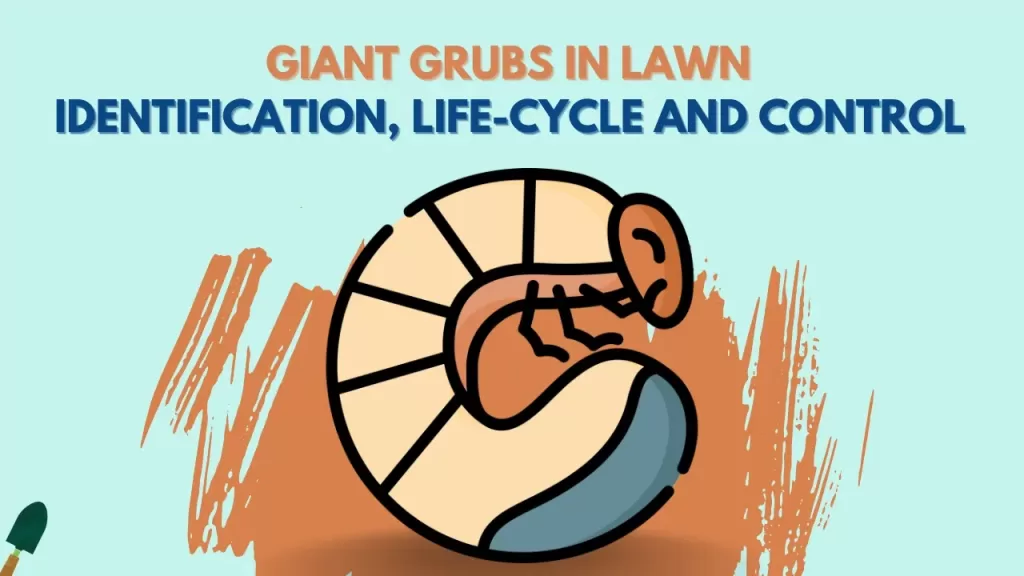If you are seeing damage in your lawn after even doing proper maintenance of watering, aeration, and mowing. There can be an unusual suspect eating your lawn from underneath. These suspects are hidden below the soil and can’t be found very easily. Grubs are the most widely spread and destructive insect pests on the lawn.
Giant grubs are the larvae of several species of beetles including Japanese beetles, masked chafers, June beetles, May beetles, and black ataenius. These giant grubs are usually C-shaped and are typically in white with a brown head. Depending on the species, these grubs can vary in size from ½ inch to 2 inches. These grubs feed on the grassroots and get mature and complete the development in one year.
But how do these giant grubs come into your lawn and how can you prevent your lawn from getting damaged by grubs? Let’s talk about this in detail.
What Is A Giant Grub?
Giant grubs are the immature larvae of several different species of scarab beetles. These grubs are usually seen in white color and that’s why they are also called white grubs. The giant grub spices or scarab beetle family includes Japanese beetles, masked chafers, June beetles, May beetles, and black ataenius. All of these species of beetles can damage your turf very easily.
Japanese beetles and masked chafers beetle larvae are the most destructive species of grubs in their adult form and the green June beetle is the one that grows the largest of them all and can grow up to 2 inches. Other than turf grass, these giant grubs can also cause damage to ornamental plants, vegetables, and trees.
When these grubs eat the roots of the grass, it takes away the ability of the grass to take nutrients and water from the soil which then makes the grass slowly become brown and dry and then eventually die in some days.
How To Identify Giant Grubs?
Grubs have stout, with white to creamish color body and brown head but other than this, all the species of grub vary significantly. They also have a dark area at their posterior end and this area is the beetle’s body which can be seen through the transparent white skin.
These giant grubs are usually seen C-shaped underneath the soil. May and June beetles are relatively large and can grow from 1 to 2 inches and Japanese and masked cheffer are usually ½ inches long.
Giant Grub Life Cycle
The grub grows in three stages in its whole life cycle to develop as a beetle:
- Hatching
- Dormancy
- Maturity
Hatching – the adult beetle lays eggs in the soil in the summer between June to August depending on the species. Then these eggs hatch in one to two weeks and become larvae which then eat the root of the turf. Some eggs can die in the heat of the sun due to lack of moisture and stress.
Dormancy – after the hatching and feeding from the grassroots until fall, these grubs go deep into the soil in the winter season. They stay deep into the soil to protect themselves from winterization as the soil is warmer down there.
Maturity – in spring, after the last frost, these grubs come back to the top of the soil and eat the roots until late May when they are mature enough to transform themselves into pupae and then into a beetle.
This whole process from laying an egg to becoming a beetle takes around one whole year.
How And When To Check If Your Lawn Is Infested With Giant Grubs?
The usual time when you see the effect of grub damage is in spring and fall and most evident in August and September. This is because the grub is mostly active in spring and fall and goes into dormancy in the winter season.
The grass will first start to turn yellow and then brown because the grub feeds on the root of the grass which makes the grass unable to get water and nutrients from the soil due to damaged roots. If the grub infestation is heavy, the turf will feel loose and spongy and you can roll turf back just like a rug and can see severed roots and grub infestation.
To measure the level of infestation, take the help of the spade and lift a 1-foot piece of the sod 3 inches thick. Inspect the soil for the roots of the grass and thatch closely and also check the soil for the grubs. A healthy lawn can tolerate 2-3 grubs per square foot but if you have more than 3 grubs per square foot then you need to take care of the lawn by killing and removing these from the lawn.
Grubs also attract birds, raccoons, skunks, and other insect-eating wildlife which can cause digging and disruption in the lawn turf. This disruption can also be an indication of grub infestation in your lawn.
How To Treat Giant Grubs On Your Lawn?
There are two ways to treat the giant grubs on your lawn. The first way is to prevent the grubs in the lawn before they even start to damage the turf in your lawn and the other is to control the grub and bring back your lawn to life after grub damage. Let’s talk about both ways in detail.
Prevention
As the saying goes prevention is better than cure. So to prevent the lawn from grub is to kill the grub before they can try to feed on the grassroots and damage the lawn. And this happens two times in the year. First when the mature grubs come back from the deep to the top in spring and the other is in fall when the new grubs are born from the eggs.
If you want to prevent the grub infestation in the lawn then spray the insecticide in early spring and in fall to kill these grubs as they are vulnerable at these times and can be controlled very easily.
If you don’t control the grubs in the spring they can cause serious damage to the lawn in summer after feeding throughout the spring and will be a lot harder to kill.
And this is also true for fall prevention as if you don’t control the newly born grub they will feed through the fall and then go deep into the soil and harder to control.
Using a good application of insecticides like Sevin® Insect Killer Granules in the early spring and the fall can control these grub infestations very easily before they even start to damage your lawn. These insecticides have a life of up to 3 months, which makes sure that all of the grubs present and or coming from deep or from eggs are killed.
Control
Controlling the grub infestation can be tough as killing them after they have become can be hard. To control the grub, first, let your lawn dry to get all the grub to come to the top of the soil, and then apply an insecticide on the whole lawn.
You need to apply insecticide one or more times in the lawn after you have found the grub infestation to kill off all the grub and to make sure the lawn is safe. You can use Sevin® Insect Killer Granules or Sevin® Insect Killer Concentrate to control the grub as they are very effective and can give results up to 3 months.
To properly apply the insecticide, first, mow the lawn to 2-3 inches tall so that the application can go properly into the turf. After the application, water thoroughly after the application so that the insecticide can go deep into the soil as grub can go deep into the soil and protect itself.
How Big Can A Grub Get?
A big grub can get up to 2 inches long when it fully matures. The length of the grub can vary according to their spices but the longest is from the green June beetle which usually grows between 1.5 to 2 inches long.
Can A Grub Bite?
No, lawn grub doesn’t bite and are known to be harmless but they have a slimy texture on their skin that can cause irritation in your skin and can cause rash, scratching, or redness.
Are Grubs Good For Gardens?
No, grubs are not good for your garden, as they eat the roots of the grass and plants and can damage your whole lawn and garden very easily. They can destroy your lawn and can cause damage and diseases in vegetable leaves.
What Do Huge Grubs Turn Into?
Huge grubs or giant grubs are a species of beetle larvae. These grubs turn into mature beetles after completing their grub life cycle. The beetles lay eggs and these eggs give birth to larvae. It takes around one year for a grub to develop and become a beetle.
What Is The Largest Grub?
Hercules beetle is one the largest grub species which is found in central and south America. The larvae of June beetles which are commonly found in North America are also very large grubs that can grow up to 2 inches.


